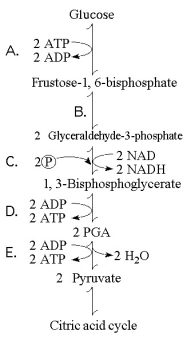Multiple Choice
Refer to Figure 9.1 to answer the following questions.
Figure 9.1 illustrates some of the steps (reactions) of glycolysis in their proper sequence. Each step is lettered. Use these letters to answer the questions.

-The free energy for the oxidation of glucose to CO₂ and water is -686 kcal/mole and the free energy for the reduction of NAD+ to NADH is +53 kcal/mole. Why are only two molecules of NADH formed during glycolysis when it appears that as many as a dozen could be formed?
A) Most of the free energy available from the oxidation of glucose is used in the production of ATP in glycolysis.
B) Glycolysis is a very inefficient reaction, with much of the energy of glucose released as heat.
C) Most of the free energy available from the oxidation of glucose remains in pyruvate, one of the products of glycolysis.
D) There is no CO₂ or water produced as products of glycolysis.
E) Glycolysis consists of many enzymatic reactions, each of which extracts some energy from the glucose molecule.
Correct Answer:

Verified
Correct Answer:
Verified
Q28: What is the purpose of beta oxidation
Q77: Figure 9.3 <img src="https://d2lvgg3v3hfg70.cloudfront.net/TB2680/.jpg" alt="Figure 9.3
Q78: Refer to Figure 9.2, showing the citric
Q79: Figure 9.3 <img src="https://d2lvgg3v3hfg70.cloudfront.net/TB2680/.jpg" alt="Figure 9.3
Q81: When electrons move closer to a more
Q83: Use the following to answer the following
Q84: Refer to Figure 9.2, showing the citric
Q85: Figure 9.3 <img src="https://d2lvgg3v3hfg70.cloudfront.net/TB2680/.jpg" alt="Figure 9.3
Q86: Why does the oxidation of organic compounds
Q87: Refer to Figure 9.2, showing the citric